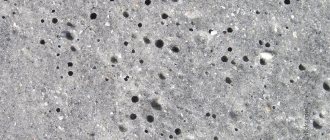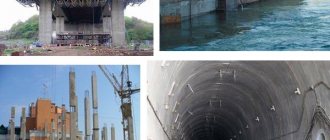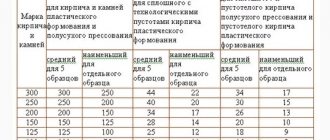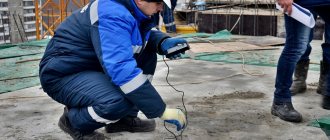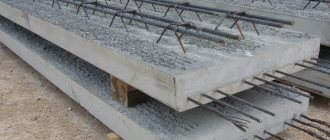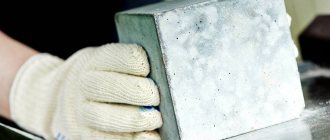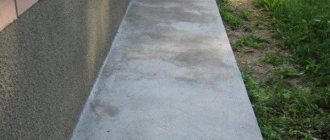About what kind of concrete there is, the ratio of cement, sand, gravel, concrete grade, sediment, frost resistance and water resistance coefficients, concrete hardening.
Concrete, when it comes to its purchase and delivery, is not quite the correct name to use. You buy a ready-made concrete mixture from STROYTECH PSK (the abbreviation BSG is used in the technical documentation), and it will become concrete after it is poured into the formwork and begins to harden. The concrete mixture is also called ready-mixed concrete - it is a mixture mixed at a concrete plant, which is subsequently transported and laid on site.
Ready-mix concrete or concrete mixture consists of components mixed in a certain proportion: cement, crushed stone, sand and water. If you do not add crushed stone to this mixture, you will get cement mortar or sand concrete - it uses sand of a larger fraction (fineness modulus).
The ratio of components in the concrete mixture by weight is approximately the following: cement - 1 part, crushed stone - 4 parts, sand - 2 parts, water - 0.55 parts.
For example, cement - 330 kg, crushed stone - 1250 kg, 660 kg, 180 l.
Of course, these figures are arbitrary, since in reality they depend on many conditions: the grade of concrete and cement, the characteristics of crushed stone and sand, the use of plasticizers and other additives, etc. When producing concrete at STROYTECH PSK, dozens of parameters and factors are taken into account.
The main components of concrete are water and cement; they bind all the components into a single mass. The correct proportion of these two components is the most important task in concrete production. In addition to the ratio of water and cement introduced into concrete, it is necessary to take into account the moisture absorption and moisture content of sand and crushed stone. When cement interacts with water, cement stone is formed. But despite the apparent simplicity and self-sufficiency of these two components, the problem lies in the deformation of the cement stone during hardening - volumetric shrinkage reaches 2 mm/m. Due to the unevenness of shrinkage processes, microcracks and internal stress occur, which leads to a decrease in the durability of the cement stone. To avoid this, use placeholders:
— crushed stone (coarse aggregate)
- sand (fine aggregate)
Fillers create a structural frame that absorbs shrinkage stress; as a result, concrete shrinks less, the strength and elastic modulus of concrete increases (reduced deformations under load), and creep decreases (irreversible changes under long-term loads). In addition, aggregates make concrete cheaper because cement is more expensive than sand and crushed stone.
Let's take the components of the concrete mixture in volume:
- Cement 0.25 cubic meters (330 kg. Bulk density of cement on average 1300 kg per cubic meter)
- Water 0.18 cubic meters (180 liters. Liters, they are also liters in Africa)
- Crushed stone 0.9 cubic meters (1250 kg. With a bulk density of 1350 kg per cubic meter)
- Sand 0.43 cubic meters (600 kg. With a bulk density of 1400 kg/cubic.)
If you put everything into different containers and count, the total volume will be 1.76 cubic meters. But from this you can easily get one cube of concrete. Fill a liter jar with crushed stone to the brim. We fill the remaining voids (intergranular voids) with sand, cement and water, shaking the jar in the process. The result is a dense substance - everything is filled, all components rest against each other, there are no voids. If the concrete is not disturbed, it will soon begin to harden. It will return to a plastic state when vibrating and shaking - this phenomenon is called thixotropy. When at rest, it will begin to turn into an elastic mass.
Crushed stone
It is best to choose the grade (strength) of crushed stone that is twice as high as the calculated grade of concrete. This is due to the fact that the design (28-day) grade of concrete is always much lower than its actual strength, which will appear within six months to a year. But the strength of crushed stone does not change over time, so they are leveled. This is done just in case, without necessarily agreeing with the design safety margin requirements. Excerpt from GOST 26633-91
There are three main types of crushed stone:
— Limestone (average strength 500-600). Limestone is most often used for the production of concrete grades m-100-m-300 due to its relatively low frost resistance, but some of its types (up to 800) are suitable for more durable concrete - up to m-350.
— Gravel is the most common filler due to the set of all the necessary characteristics for the production of most concrete mixtures. The main types of gravel (strength 800-1000) can be used to produce concrete grades up to m-450 (but not higher than m-400). It is recommended for private construction - due to its relative cheapness and strength sufficient for individual construction.
— Granite is the most durable of the listed fillers (m up to 1400). It has low water absorption and increased frost resistance. For example, only granite crushed stone is allowed for road construction.
In addition, there are some points associated with crushed stone that need to be taken into account: flakiness, percentage of weak rock grains and others.
Concrete to create a strong foundation
Concrete is most often used to lay a solid foundation for a structure; if the material is chosen correctly, the structure will last for decades. Experts recommend choosing the following grades of material for different types of buildings:
- If the building involves a prefabricated panel structure, concrete should be purchased in M200 format; for a wooden house or steam room, the ideal option is M250.
- If construction involves expanded clay concrete and gas silicate blocks, it is better to purchase M300.
- Brickwork and reinforced concrete wall panels require a more powerful base - M 350.
Also consider the nature of the soil on which construction is carried out:
- if the soil is rocky or sandy, you should not buy the strongest concrete, rely on the design load of the structure;
- high grades M500 are intended for the construction of monolithic houses of several floors on clay and loamy soils.
If you plan to arrange a basement, the brand should be chosen an order of magnitude higher.
Concrete grade (M)
In all information materials, price lists, etc. concrete is indicated with a digital and letter index. Brand M-, class B-, mobility P-, water resistance W-, frost resistance F- must be indicated
Your project determines the choice of a specific type and grade of concrete. If there is no project, then you can listen to the advice of builders or figure it out yourself.
The numbers for the concrete grade indicate the average compressive strength in kgf/sq.cm. Compliance with the declared brand of concrete is checked by casting a mixture of cubes or cylinders from a sample and allowing them to harden for 28 days.
Currently, such a characteristic of concrete as a class is used - this is approximately the same as a grade, but with the only difference that the grades indicate the average value of strength, and the grades indicate strength with guaranteed security with a coefficient of variation of 13%. In accordance with ST SEV 1460, all modern design requirements are indicated in classes, although most construction companies use a brand for ordering.
It is important for you that the brand of concrete matches the one you ordered. How to check? To do this, you need to take a sample and cast from it several cubes measuring 10X10X10 cm or 15X15X15 cm. It is most convenient to use the necessary forms knocked together from planks, having previously moistened them so that they do not absorb the water included in the concrete and do not interfere with hydration. For the purity of the experiment, it is necessary to pierce the poured mixture so that there are no air voids left. You can also compact the mixture by hitting the sides of the mold with a hammer. Samples should be taken directly from the concrete carrier tray, do not dilute the mixture in a concrete mixer truck, thoroughly compact the mixture in the molds and store at medium temperature (about 20 C) and high humidity.
After 28 days, any independent laboratory can check the compliance of the brand of your concrete with the declared one.
There are also intermediate stages of hardening - 3, 7, 14 days. During the first seven days, concrete gains 70% of its strength. There are also other methods for determining strength - these are the so-called indestructible “on-site” measurement methods. These include the shock pulse method (“tapping the concrete”), ultrasonic methods and others. Concrete class
| Average strength of concrete of this class, kgf/sq.cm | Nearest brand of concrete | |
| В3.5 В5 В7.5 В10 В12.5 В15 В20 В25 В30 В35 В40 В45 В50 В55 В60 | 46 65 98 131 164 196 262 327 393 458 524 589 655 720 786 | M50 M75 M100 M150 M150 M200 M250 M350 M400 M450 M550 M600 M600 M700 M800 |
Testing concrete for frost resistance
To establish the level of frost resistance of concrete, specially made samples from the building mixture are subjected to artificial freezing and thawing, then frozen again, etc. During the process, the laboratory technician records the weight, compressive/tensile strength, elasticity and other indicators of the product. The percentage of concrete mass loss is calculated. Damage to the monolith is recorded.
The reagents used in the frost resistance testing procedure are distilled water and a 35% sodium chloride solution. The latter makes it possible to determine the resistance of the material to the effects of defrosting salts.
Preparation
- Five cubic containers of 10\10\10 cm are filled with mortar. So that during testing the specialist can control the temperature regime, a thermoelement is placed in one of the samples.
- During drying, the samples are placed in a room with a temperature of 200.± 2C0. At the same time, it is necessary to protect them from drying out.
- After a day, the samples are removed from the molds and placed in a water bath for a week.
- After which, each sample is placed for 27 days in a special climate chamber.
- After removal, the samples are weighed on a sensitive balance. It is important to take into account every lost gram.
- The next step is to completely immerse the cubes for a day in a saline solution, 2-3 centimeters above the upper rib. The liquid temperature remains around 18-20 C0.
- Again, samples are weighed to the milligram. The difference in weight before and after immersion in the solution is the water absorption coefficient. It is presented in the form of a mathematical formula: L = (m28 - m27) / m27 * 100, where the determined L is the capillary absorption of water, m28 is the weight of the cube after soaking on the 28th day, and m27 is the weight of the same cube after the climatic chamber on the 27th day.
Carrying out the test
- Hermetically sealed containers with concrete samples immersed in a liquid medium are placed in a freezer.
- The process of alternate freezing/thawing starts according to the established schedule. The sub-zero temperature in the chamber should not fall below -25 C0.
- The freezing phase of the samples lasts 16 hours, followed by a thawing period of 8 hours. During this process, it is necessary to maintain the level of the solution in the container, which should not reach the upper edge of 18-22 millimeters. And the temperature of the liquid should not exceed 22 degrees.
- When there are 15 minutes left before the completion of the thawing stage, the laboratory assistant pumps out the solution. Next, the container is filled with fresh solution and the next freezing/thawing cycle starts.
- The thawing process requires compliance with the temperature regime. For this purpose, a thermoelement is used, which was installed in one of the samples. During the formation of a concrete cube.
- The duration of the test is 56 cycles. One of them must be monitored from the moment of freezing until the liquid is changed to a fresh solution.
- During testing, samples must be moved inside the freezer, changing their original location, at least once a week. In this case, you should rotate them by 1800.
- Samples are subjected to detailed examination every 7 cycles. All changes visible to the eye and indicators of instrumental measurements are recorded in the protocol. The fallen particles are dried using a special technology and weighed with an accuracy of milligrams.
Processing the results
To calculate the degree of frost resistance of concrete, take the arithmetic average of all the obtained indicators of 5 samples that have gone through 56 freezing/defrosting cycles.
For data analysis, samples are divided into pairs. Determine the loss for 2 samples from one container after 7 cycles using the mathematical formula: Pn = ms1n / m0 * 100. Where Pn is the required weight loss coefficient of the test sample. The mass of detached particles from the whole sample is represented in the form ms1n. It is measured with an accuracy of 0.1 g. And m0 is the weight of these samples dried for 27 days. After all the calculations, the specialist determines and assigns a frost resistance class for the concrete that has been tested
Workability, mobility, cone draft (P)
These three concepts, in principle, describe the same concrete characteristic, which is denoted by the letter P with a coefficient from 1 to 5, or as “cone slump 10-15 cm.” For standard monolithic work, concrete with mobility P-2 and P-3 is used. For difficult-to-fill structures, such as columns, narrow formworks and densely reinforced cavities, it is advisable to use concrete P-4 and higher (cone draft 16-21 cm). This type of concrete is called cast concrete; it fits well into formwork without the use of a vibrator.
Concrete stiffness (denoted by the letters Zh1-Zh4) is a characteristic related to concrete used mainly in road construction.
Under no circumstances should water be added to concrete to increase its mobility, since, as mentioned above, the water-cement ratio is a key proportion on which the strength of concrete depends. Even due to a slight increase in the amount of water in the mixture, the grade of concrete can decrease from m-400 to m-300-m-200. To increase the mobility of the mixture to indicators P4, P5, PSK STROYTECH uses plasticizers - this is the only sure way to produce cast concrete intended for laying in formwork with a dense frame of reinforcement, or for monolithic work using a concrete pump.
Concrete frost resistance coefficient (F)
The frost resistance coefficient of concrete is the number of freezing-thawing cycles of concrete during which it retains its original characteristics. Denoted by the letter F with a number from 25-1000.
How does this happen on sites? For example, groundwater penetrates into the foundation at the capillary level and freezes there when the temperature drops. Freezing, water expands and tears apart the concrete - microcracks form. Next time, the water will further increase the “habitable” place, which, you see, will reduce the strength of concrete. Of course, this is a theory; in practice, foundations are protected by waterproofing and blind areas with water-repellent agents.
At STROYTECH PSK, concrete samples are tested for frost resistance in critical conditions. The concrete cube is saturated “full” with water or a special solution and frozen to -18. In the intervals, the strength is measured until a critical point is reached - loss of the declared strength. The number of such water-ice cycles is the frost resistance coefficient of concrete.
To increase the frost resistance coefficient, factories for the production of concrete products use various additives to concrete, for example, air-entraining ones. But in this case its strength decreases. The best results are obtained from using hydrophobic or prestressing cement in mixing concrete.
In private construction, the average frost resistance is F100-F200.
Waterproof coefficient
The water resistance of concrete is its ability not to allow water under pressure to pass through it; it is inextricably linked with frost resistance. It is designated by the letter W with a coefficient from 1 to 20. To increase water resistance, sealing and water-repellent additives are introduced into concrete in factories or hydrophobic or prestressing cement is used to mix the mixture.
Concrete with a high coefficient of waterproofing allows the construction of basements in places with high groundwater levels without additional waterproofing, if the walls and floors are poured professionally without seams or interruptions. In addition, such concrete is durable - their frost resistance coefficient is high, which is ideal for unprotected structures, such as concrete paths, blind areas, fence strips, as well as for pile foundations on moisture-saturated soils. However, such concrete is not cheap due to high grades (with a high cement content); special conditions are also required to deliver and lay it on site due to the fast setting time.
Finally, once again about what can cause concrete to deteriorate:
Firstly, do not under any circumstances dilute the concrete with water when laying it. Liquid concrete is easier to lay than solid concrete, but by violating the water-cement ratio, you will thereby significantly reduce its grade and reduce its strength.
Secondly, observe all the necessary conditions for transporting concrete in a mixer, unloading time, and take into account the weather.
Thirdly, compact the mixture efficiently; voids left in the concrete due to lack of vibration when laying reduce the quality of the concrete.
Compliance with class, frost resistance and water resistance
The higher the strength grade, the higher the frost resistance and water resistance. The correspondence between these characteristics for standard grades of concrete is given in the table:
| Concrete grade | Concrete class | Frost resistance F | Waterproof W |
| concrete m100 | B-7.5 | F50 | W2 |
| concrete m150 | V-12.5 | F50 | W2 |
| concrete m200 | B-15 | F100 | W4 |
| concrete m250 | IN 20 | F100 | W4 |
| concrete m300 | V-22.5 | F200 | W6 |
| concrete m350 | B-25 | F200 | W8 |
| concrete m400 | B-30 | F300 | W10 |
| concrete m450 | B-35 | F200-F300 | W8-W14 |
| concrete m550 | B-40 | F200-F300 | W10-W16 |
| concrete m600 | B-45 | F100-F300 | W12-W18 |
The frost resistance and water resistance of concrete can be increased through the use of special additives.
